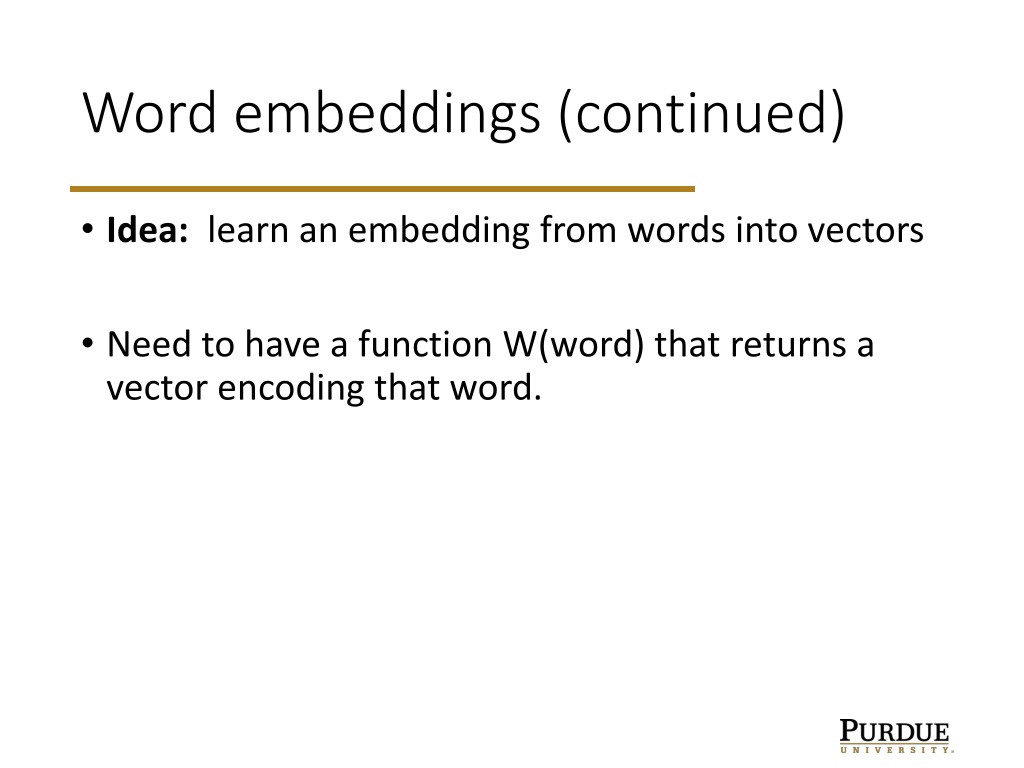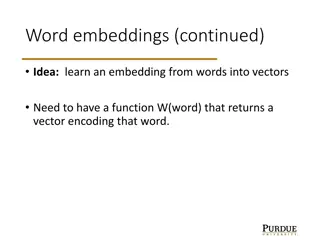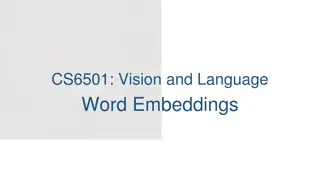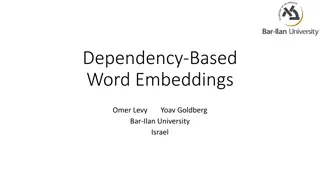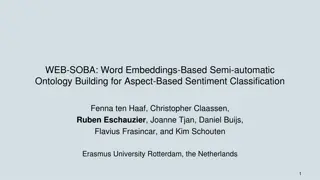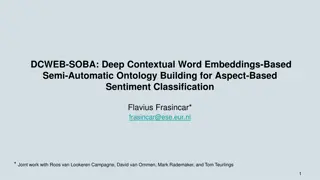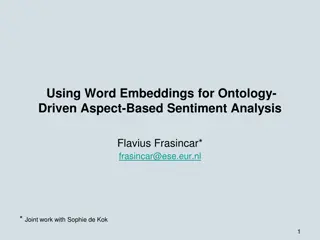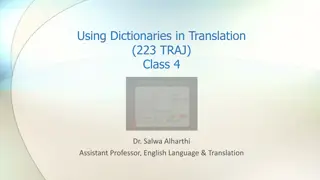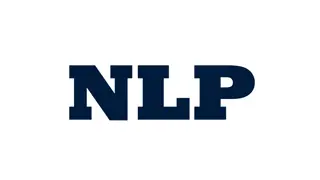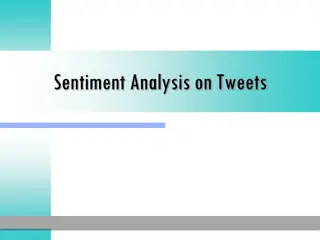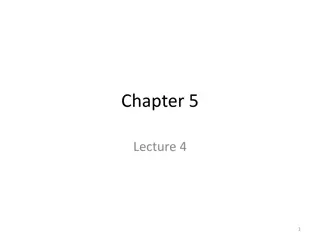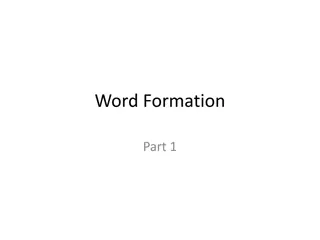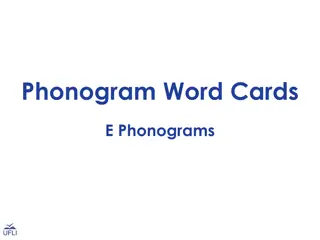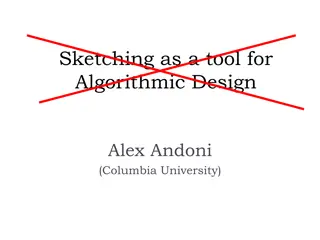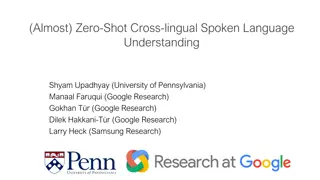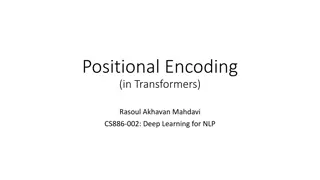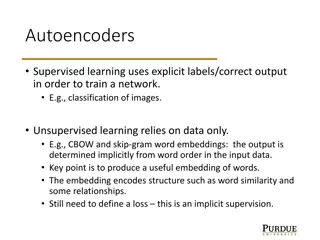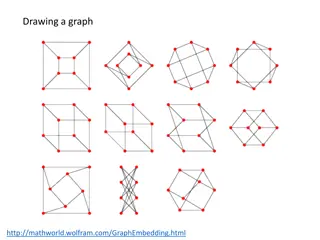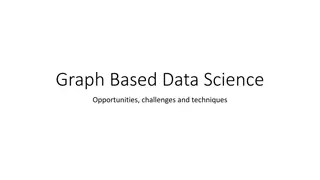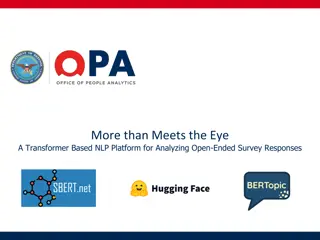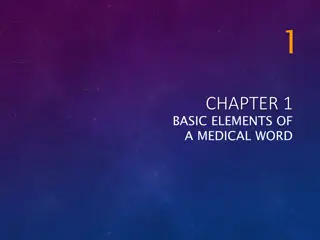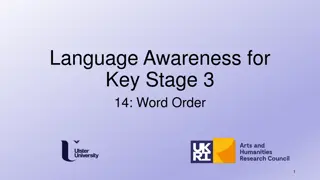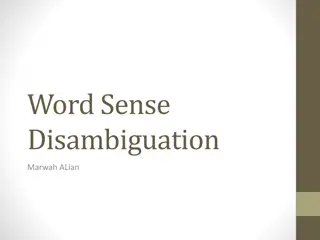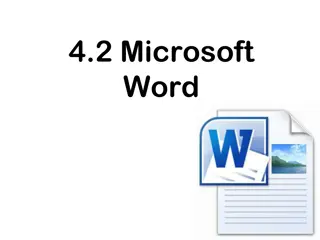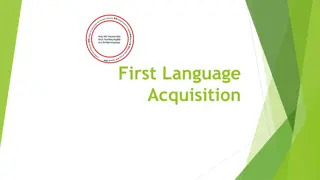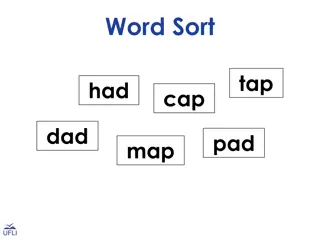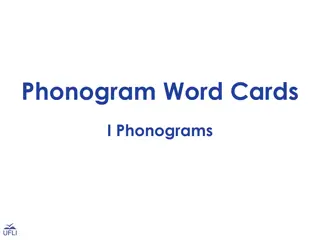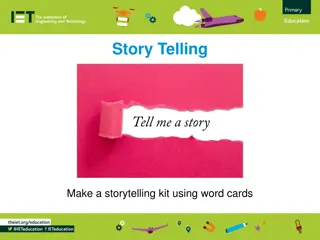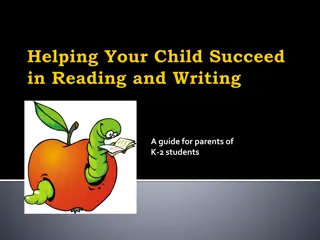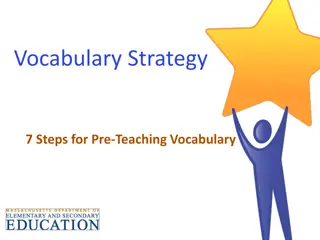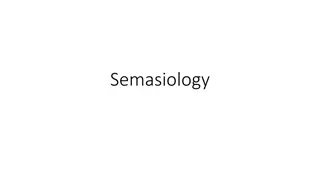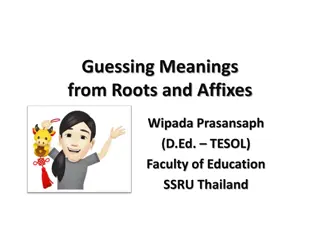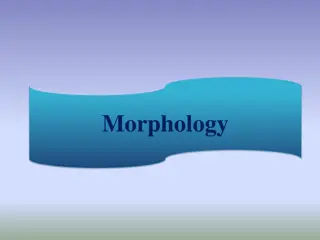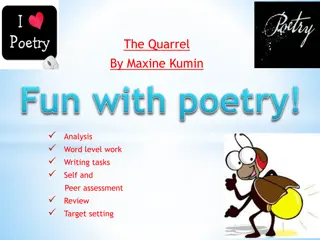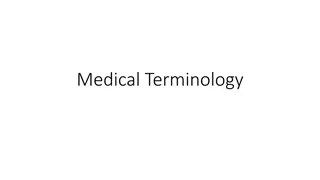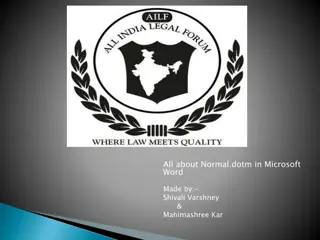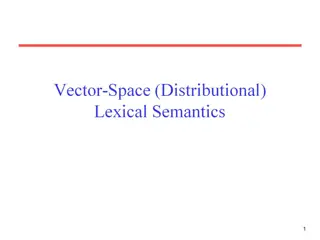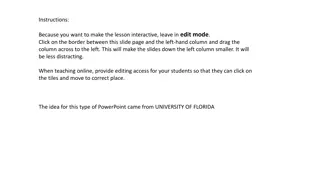Understanding Word Embeddings: A Comprehensive Overview
Word embeddings involve learning an encoding for words into vectors to capture relationships between them. Functions like W(word) return vector encodings for specific words, aiding in tasks like prediction and classification. Techniques such as word2vec offer methods like CBOW and Skip-gram to predict words from context, showcasing the importance of embedding spaces and optimization strategies.
Download Presentation

Please find below an Image/Link to download the presentation.
The content on the website is provided AS IS for your information and personal use only. It may not be sold, licensed, or shared on other websites without obtaining consent from the author. Download presentation by click this link. If you encounter any issues during the download, it is possible that the publisher has removed the file from their server.
E N D
Presentation Transcript
Word embeddings (continued) Idea: learn an embedding from words into vectors Need to have a function W(word) that returns a vector encoding that word.
Word embeddings: properties Relationships between words correspond to difference between vectors. http://colah.github.io/posts/2014-07-NLP-RNNs-Representations/
Word embeddings: questions How big should the embedding space be? Trade-offs like any other machine learning problem greater capacity versus efficiency and overfitting. How do we find W? Often as part of a prediction or classification task involving neighboring words.
Learning word embeddings First attempt: Input data is sets of 5 words from a meaningful sentence. E.g., one of the best places . Modify half of them by replacing middle word with a random word. one of function best places W is a map (depending on parameters, Q) from words to 50 dim l vectors. E.g., a look-up table or an RNN. Feed 5 embeddings into a module R to determine valid or invalid Optimize over Q to predict better https://arxiv.org/ftp/arxiv/papers/1102/1102.1808.pdf http://colah.github.io/posts/2014-07-NLP-RNNs-Representations/
word2vec Predict words using context Two versions: CBOW (continuous bag of words) and Skip-gram https://skymind.ai/wiki/word2vec
CBOW Bag of words Gets rid of word order. Used in discrete case using counts of words that appear. CBOW Takes vector embeddings of n words before target and n words after and adds them (as vectors). Also removes word order, but the vector sum is meaningful enough to deduce missing word.
Word2vec Continuous Bag of Word E.g. The cat sat on floor Window size = 2 the cat sat on floor 7 www.cs.ucr.edu/~vagelis/classes/CS242/slides/word2vec.pptx
Input layer Input layer 0 0 Index of cat in vocabulary Index of cat in vocabulary 1 1 0 0 0 0 Hidden layer Hidden layer Output layer Output layer cat cat 0 0 0 0 0 0 0 0 0 0 0 0 0 0 0 0 0 0 one-hot vector vector one-hot vector vector one-hot one-hot 0 0 sat sat 0 0 0 0 0 0 1 1 0 0 0 0 0 0 1 1 0 0 on on 0 0 0 0 0 0 0 0 8 12 www.cs.ucr.edu/~vagelis/classes/CS242/slides/word2vec.pptx www.cs.ucr.edu/~vagelis/classes/CS242/slides/word2vec.pptx
We must learn W and W Input layer 0 1 0 0 Hidden layer Output layer cat ?? ? 0 0 0 0 0 0 0 V-dim 0 0 ? ? ? 0 sat 0 0 0 1 0 0 N-dim ?? ? V-dim 0 1 0 on 0 0 0 V-dim N will be the size of word vector 0 9 www.cs.ucr.edu/~vagelis/classes/CS242/slides/word2vec.pptx
? ?? ? ????= ???? 0 0.1 2.4 1.6 1.8 0.5 0.9 3.2 2.4 1 Input layer 0.5 2.6 1.4 2.9 1.5 3.6 6.1 2.6 0 = 0 0 1 0 0 0 0.6 1.8 2.7 1.9 2.4 2.0 1.2 1.8 0 0 Output layer xcat 0 0 0 0 0 0 0 0 0 V-dim 0 0 ? =????+ ??? 0 + sat 2 0 0 0 1 0 0 V-dim 0 1 Hidden layer 0 xon 0 N-dim 0 0 V-dim 0 10 www.cs.ucr.edu/~vagelis/classes/CS242/slides/word2vec.pptx
? ?? ? ???= ??? 0 0.1 2.4 1.6 1.8 0.5 0.9 3.2 1.8 0 Input layer 0.5 2.6 1.4 2.9 1.5 3.6 6.1 2.9 0 = 0 1 1 0 0 0 0.6 1.8 2.7 1.9 2.4 2.0 1.2 1.9 0 0 Output layer xcat 0 0 0 0 0 0 0 0 0 V-dim 0 0 ? =????+ ??? 0 + sat 2 0 0 0 1 0 0 V-dim 0 1 Hidden layer 0 xon 0 N-dim 0 0 V-dim 0 11 www.cs.ucr.edu/~vagelis/classes/CS242/slides/word2vec.pptx
Input layer 0 1 0 0 Hidden layer Output layer cat ?? ? 0 0 0 0 0 0 0 V-dim 0 0 ? = ???????(?) ?? ? ? = ? 0 0 0 0 1 0 ? 0 ?? ? 0 1 N-dim 0 on ?sat 0 0 V-dim 0 V-dim N will be the size of word vector 0 12 www.cs.ucr.edu/~vagelis/classes/CS242/slides/word2vec.pptx
Input layer 0 We would prefer ? close to ???? 1 0 0 Hidden layer Output layer cat ?? ? 0 0 0 0 0.01 0 0 0.02 0 V-dim 0.00 0 0 ?? ? ? = ???????(?) ? = ? 0 0.02 0 0.01 0 0 1 0 0.02 ? 0 0.01 ?? ? 0 1 0.7 N-dim 0 on ?sat 0 0 V-dim 0.00 0 ? V-dim N will be the size of word vector 0 13 www.cs.ucr.edu/~vagelis/classes/CS242/slides/word2vec.pptx
? ?? ? 0.1 2.4 1.6 1.8 0.5 0.9 3.2 Contain word s vectors Input layer 0.5 2.6 1.4 2.9 1.5 3.6 6.1 0 1 0 0.6 1.8 2.7 1.9 2.4 2.0 1.2 0 Output layer xcat 0 0 0 0 ?? ? 0 0 0 V-dim 0 0 ?? ? 0 sat 0 0 0 1 0 0 ?? ? V-dim 0 1 Hidden layer 0 xon 0 N-dim 0 0 V-dim 0 We can consider either W or W as the word s representation. Or even take the average. 14 www.cs.ucr.edu/~vagelis/classes/CS242/slides/word2vec.pptx
Some interesting results 15 www.cs.ucr.edu/~vagelis/classes/CS242/slides/word2vec.pptx
Word analogies 16 www.cs.ucr.edu/~vagelis/classes/CS242/slides/word2vec.pptx
Skip gram Skip gram alternative to CBOW Start with a single word embedding and try to predict the surrounding words. Much less well-defined problem, but works better in practice (scales better).
Skip gram Map from center word to probability on surrounding words. One input/output unit below. There is no activation function on the hidden layer neurons, but the output neurons use softmax. http://mccormickml.com/2016/04/19/word2vec-tutorial-the-skip-gram-model/
Skip gram example Vocabulary of 10,000 words. Embedding vectors with 300 features. So the hidden layer is going to be represented by a weight matrix with 10,000 rows (multiply by vector on the left). http://mccormickml.com/2016/04/19/word2vec-tutorial-the-skip-gram-model/
Skip gram/CBOW intuition Similar contexts (that is, what words are likely to appear around them), lead to similar embeddings for two words. One way for the network to output similar context predictions for these two words is if the word vectors are similar. So, if two words have similar contexts, then the network is motivated to learn similar word vectors for these two words! http://mccormickml.com/2016/04/19/word2vec-tutorial-the-skip-gram-model/
Word2vec shortcomings Problem: 10,000 words and 300 dim embedding gives a large parameter space to learn. And 10K words is minimal for real applications. Slow to train, and need lots of data, particularly to learn uncommon words.
Word2vec improvements: word pairs and phrases Idea: Treat common word pairs or phrases as single words. E.g., Boston Globe (newspaper) is different from Boston and Globe separately. Embed Boston Globe as a single word/phrase. Method: make phrases out of words which occur together often relative to the number of individual occurrences. Prefer phrases made of infrequent words in order to avoid making phrases out of common words like and the or this is . Pros/cons: Increases vocabulary size but decreases training expense. Results: Led to 3 million words trained on 100 billion words from a Google News dataset.
Word2vec improvements: subsample frequent words Idea: Subsample frequent words to decrease the number of training examples. The probability that we cut the word is related to the word s frequency. More common words are cut more. Uncommon words (anything < 0.26% of total words) are kept E.g., remove some occurrences of the. Method: For each word, cut the word with probability related to the word s frequency. Benefits: If we have a window size of 10, and we remove a specific instance of the from our text: As we train on the remaining words, the will not appear in any of their context windows.
Word2vec improvements: selective updates Idea: Use Negative Sampling , which causes each training sample to update only a small percentage of the model s weights. Observation: A correct output of the network is a one-hot vector. That is, one neuron should output a 1, and all of the other thousands of output neurons to output a 0. Method: With negative sampling, randomly select just a small number of negative words (let s say 5) to update the weights for. (In this context, a negative word is one for which we want the network to output a 0 for). We will also still update the weights for our positive word.
Word embedding applications The use of word representations has become a key secret sauce for the success of many NLP systems in recent years, across tasks including named entity recognition, part-of-speech tagging, parsing, and semantic role labeling. (Luong et al. (2013)) Learning a good representation on a task A and then using it on a task B is one of the major tricks in the Deep Learning toolbox. Pretraining, transfer learning, and multi-task learning. Can allow the representation to learn from more than one kind of data. http://colah.github.io/posts/2014-07-NLP-RNNs-Representations/
Word embedding applications Can learn to map multiple kinds of data into a single representation. E.g., bilingual English and Mandarin Chinese word-embedding as in Socher et al. (2013a). Embed as above, but words that are known as close translations should be close together. Words we didn t know were translations end up close together! Structures of two languages get pulled into alignment. http://colah.github.io/posts/2014-07-NLP-RNNs-Representations/
Word embedding applications Can apply to get a joint embedding of words and images or other multi-modal data sets. New classes map near similar existing classes: e.g., if cat is unknown, cat images map near dog. http://colah.github.io/posts/2014-07-NLP-RNNs-Representations/
